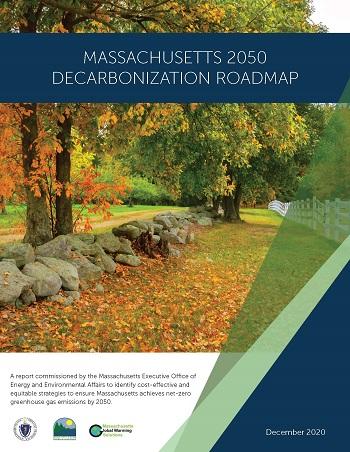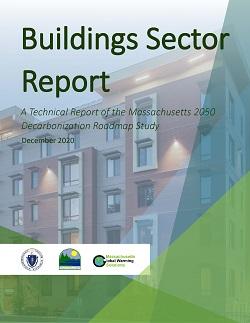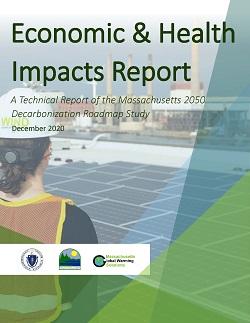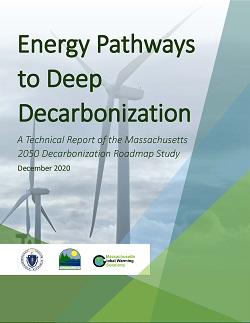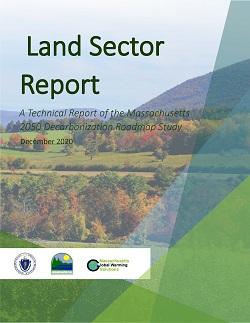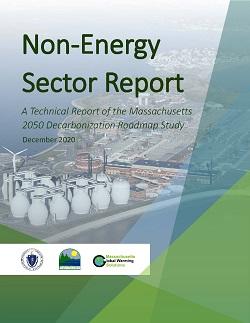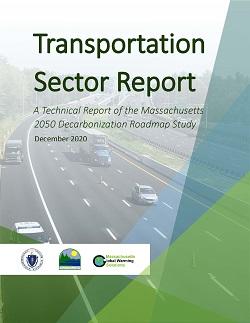Final Reports
The Decarbonization Roadmap final reports were published in December, 2020. Details on webinar and public engagement opportunities are below.
The Massachusetts 2050 Decarbonization Roadmap is available here in the following forms:
- Full Report: MA 2050 Decarbonization Roadmap
- Abridged Reports: English; Português/Portuguese; Tiếng Việt/Vietnamese; 中文/Chinese (Traditional); Kreyòl ayisyen/Haitian Creole; Español/Spanish
- Full Report, low resolution: MA Decarbonization Roadmap--Lower Resolution
- EEA hosted a Roadmap Q&A Webinar on Jan 15. Webinar materials are below.
The supporting technical reports can be found here by clicking on the images (links also available in the Additional Resources Section at the bottom of this page):
Roadmap Study Data
Please contact gwsa@mass.gov to request access to data resources from the Roadmap Study. However, the energy pathways analysis has since been updated to inform the Clean Energy and Climate Plan for 2025 and 2030 and the Clean Energy and Climate Plan for 2050. A workbook of the updated energy modeling results is available at www.mass.gov/2030CECP and www.mass.gov/2050CECP.
Public Engagement
EEA hosted a Q&A Webinar to discuss and answer questions on the final 2050 Roadmap on Friday, January 15 2021.
- Slide deck available here: Jan 15 2021 Roadmap Q&A Webinar Slide Deck
- Attendee Summary: 1/15/2021 Roadmap Webinar Attendee Summary
- English Recording below and linked here: https://www.youtube.com/watch?v=QPXQXgcdlp4
Please sign up here to receive email alerts around the 2050 Roadmap and 2030 CECP.
EEA is working with stakeholders across the Commonwealth to ensure that development of the Massachusetts Decarbonization Roadmap to 2050 ("2050 Roadmap") is an inclusive policy planning effort. Stakeholders participating in this process include: the GWSA Implementation Advisory Committee (IAC), a Technical Steering Committee of local academic experts, community organizations, Environmental Justice organizations and communities, regional planning authorities, and other stakeholders to be identified. Additionally, public engagement will be an important component in the development of the roadmap, and there will be opportunities for public input. General feedback on the study can be submitted using this form at any time.
EEA had planned several in-person public meetings through March, 2020. Meetings were held in Worcester and Fall River, but out of precaution for COVID-19, the meetings in Roxbury, Pittsfield, Springfield, Lowell, and Bunker Hill/Boston were canceled. On March 27th, EEA held a public webinar with over 200 attendees. Meeting and webinar recordings, slides, and webinar comments are linked below.
In December 2020, EEA held a public webinar providing an update on the process for the 2050 Roadmap and 2030 CECP. The webinar video and materials are linked below.
- Slide deck from the 12/7/2020 Public Webinar: December 7 2020 Public Webinar Slides
- YouTube link to the recording of the 12/7/2020 Public Webinar.
- Grabación en español de webinar/Spanish Recording of Webinar 12/7/2020
- Slide deck for the Worcester and Fall River Public Meetings: March Public Meeting Slide Deck for 2050 Roadmap
- The slightly modified slide deck from the 3/27 webinar is here: 3/27/2020 Slide deck from Public Webinar
- Audio recording from the 3/9/2020 meeting in Fall River
- Audio recording from the 3/4/2020 meeting in Worcester
- YouTube link to the recording from the 3/27/2020 webinar (also embedded below)
- Comments from 3/27/2020 Public Webinar (2nd tab has logistical questions pulled out for reader ease):
Video: 2050 Decarbonization Roadmap Webinar: 1/15/2021 English
Skip this video 2050 Decarbonization Roadmap Webinar: 1/15/2021 English.Additional Resources
-
Open PDF file, 591.17 KB, December 7 2020 Public Webinar Slides (English, PDF 591.17 KB)
-
Open MP3 file, 40.24 MB, Grabación en español de webinar/Spanish Recording of Webinar 12/7/2020 (English, MP3 40.24 MB)
-
Open PDF file, 186.72 KB, MA 2050 Decarbonization Roadmap Q&A Webinar Meeting Notification (English, PDF 186.72 KB)
-
Open PDF file, 4.6 MB, Jan 15 2021 Roadmap Q&A Webinar Slide Deck (English, PDF 4.6 MB)
-
Open PDF file, 117.34 KB, 1/15/2021 Roadmap Webinar Attendee Summary (English, PDF 117.34 KB)
2050 Emissions Limit: Letter of Determination
The 2030 Emissions Limit Letter of Determination is available at www.mass.gov/2030CECP. This section details the process of setting the 2050 Net Zero Emissions Limit.
On February 26, 2020, EEA released a Draft Letter of Determination with proposed language to set a 2050 greenhouse gas emissions (GHG) limit. [Note: typo clarified in 3/4/2020 updated file]. This limit is designed to achieve net-zero GHG emissions, which Governor Baker announced during the State of the Commonwealth address on January 21, 2020. As announced in a press release, stakeholders were invited to submit written comments on the draft determination letter through 5pm on April 10, 2020. The comment period is now closed, though general feedback on the decarbonization roadmap is welcome using this form at any time. EEA received extensive comments, including verbal and written comments at public meetings and webinar held in March 2020, as well as written comments submitted. Over 200 individual comments were received through and online form or via email, with another 633 comments received from Sierra Club members.
On Earth Day, April 22nd 2020, as announced in a press release, EEA Secretary Theoharides signed the Letter of Determination, setting the 2050 emissions limit as follows:
A level of statewide greenhouse gas emissions that is equal in quantity to the amount of carbon dioxide or its equivalent that is removed from the atmosphere and stored annually by, or attributable to, the Commonwealth; provided, however, that in no event shall the level of emissions be greater than a level that is 85 percent below the 1990 level.
Additional Resources
-
Open PDF file, 208.38 KB, Draft Letter of Determination on the 2050 Emissions Limit-Revised 3/4/2020 (English, PDF 208.38 KB)
-
Open PDF file, 203 KB, Final Signed Letter of Determination for 2050 Emissions Limit (English, PDF 203 KB)
-
Open PDF file, 7.62 MB, 2050 Emissions Limit Individual Comments (English, PDF 7.62 MB)
-
Open PDF file, 10.66 MB, 2050 Emissions Limit Sierra Club Comments (English, PDF 10.66 MB)
Background Information
Signed into law in 2008, the Global Warming Solutions Act (GWSA) established a statutory framework for the Commonwealth to set statewide Greenhouse Gas (GHG) emissions reduction limits, 25% by 2020 and at least 80% by 2050 below 1990 levels, and developed implementation plans to achieve emission reductions.
The GWSA also required the Executive Office of Energy and Environmental Affairs (EEA), in developing the Clean Energy and Climate Plans (CECP), to consider the total potential costs and economic and non-economic benefits of GHG emissions reduction measures to the economy, environment and public health, using the best available economic models, emissions estimation techniques, and other scientific methods. Additionally, Governor Baker's Executive Order 569 lays out a comprehensive approach to further reduce greenhouse gas emissions, safeguard residents, municipalities, and businesses from the impacts of climate change, and build a more resilient Commonwealth. It requires coordination of GHG mitigation policies with climate change adaptation policies.
EEA is in the process of implementing the strategies and recommendations included in the 2050 Roadmap. The "no-regrets" strategy of regional coordination is being pursued through several avenues, including the New England Energy Vision. MA is part of the 6 New England states collaborating to advance a clean, affordable, and reliable 21st century regional electric grid. More information is available at www.newenglandenergyvision.com.
Research Effort
EEA has developed a roadmap to 2050 that identifies the strategies, policies, and implementation pathways for MA to achieve at least 85% GHG reductions by 2050, including multiple pathways to net-zero emissions. The 2050 Roadmap has informed the setting of the 2030 emissions limit and the development of the Interim CECP for 2030.
Analysis supporting the roadmap examines ways to decarbonize the buildings, transportation, electricity, and non-energy sectors; the role the Commonwealth's natural and working lands can play in decreasing greenhouse gas emissions; and the impacts of policy implementation, including:
- Impacts to Environmental Justice (EJ) communities;
- Economic costs and benefits;
- Public health impacts;
- Changes to the landscape; and
- Co-benefits for climate change resilience.
Timing:
The planning process to develop the Roadmap kicked-off in July 2019. Analysis continue through 2020, with the 2050 Roadmap and the CECP for 2030 published in December 2020.
Feedback and Resources
EEA has several ways to stay engaged with this work:
Sign up here to receive email alerts about upcoming webinars, meetings, and more.
Attend a public meeting
GWSA public meetings are all published on the calendar here.
Provide feedback
Do you have questions or ideas for the study? Fill out this form to contribute to the effort!
Additional Resources
-
Open PDF file, 1.48 MB, March Public Meeting Slide Deck for 2050 Roadmap (English, PDF 1.48 MB)
-
Open PDF file, 1.59 MB, 3/27/2020 Slide deck from Public Webinar (English, PDF 1.59 MB)
-
Open XLSX file, 31.38 KB, Comments from 3/27/2020 Public Webinar (English, XLSX 31.38 KB)
Final Reports Full Links
Direct links to full Roadmap report below
Additional Resources
-
Open PDF file, 1.93 MB, Non-Energy Sector Technical Report (English, PDF 1.93 MB)
-
Open PDF file, 1.75 MB, Transportation Sector Technical Report (English, PDF 1.75 MB)
-
Open PDF file, 6.85 MB, Land Sector Technical Report (English, PDF 6.85 MB)
-
Open PDF file, 19.95 MB, Energy Pathways for Deep Decarbonization Report (English, PDF 19.95 MB)
-
Open PDF file, 4.58 MB, Building Sector Technical Report (English, PDF 4.58 MB)
-
Open PDF file, 840.51 KB, Economics and Health Impacts Report (English, PDF 840.51 KB)
-
Open PDF file, 34.78 MB, MA 2050 Decarbonization Roadmap (English, PDF 34.78 MB)
-
Open PDF file, 9.82 MB, MA Decarbonization Roadmap--Lower Resolution (English, PDF 9.82 MB)
-
Open PDF file, 5.58 MB, MA Decarbonization Roadmap--Abridged English (English, PDF 5.58 MB)
-
Open PDF file, 12.97 MB, Español: MA Decarbonization Roadmap--Abridged Spanish (English, PDF 12.97 MB)
-
Open PDF file, 13.61 MB, Kreyòl ayisyen: MA Decarbonization Roadmap--Abridged Haitian Creole (English, PDF 13.61 MB)
-
Open PDF file, 13.64 MB, 中文: MA Decarbonization Roadmap--Abridged Chinese (Traditional) (English, PDF 13.64 MB)
-
Open PDF file, 12.23 MB, Tiếng Việt: MA Decarbonization Roadmap--Abridged Vietnamese (English, PDF 12.23 MB)
-
Open PDF file, 12.48 MB, Português: MA Decarbonization Roadmap--Abridged Portuguese (English, PDF 12.48 MB)
